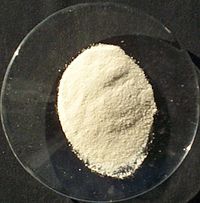
Photo from wikipedia
Nanocomposite Fe–Al oxide catalysts were prepared by the melting of iron and aluminum nitrates with the subsequent calcination in air at different temperatures. It was found that the catalysts calcined… Click to show full abstract
Nanocomposite Fe–Al oxide catalysts were prepared by the melting of iron and aluminum nitrates with the subsequent calcination in air at different temperatures. It was found that the catalysts calcined at 450 °C are more active in the oxidation of CO than the catalysts calcined at 700 °C. X-ray diffraction and X-ray photoelectron spectroscopy showed that all the catalysts consist of hematite, α-Fe2O3 nanoparticles, and Al2O3 in an amorphous state. Iron oxide is the active component, which provides the oxidation of CO, while alumina is a texture promoter. The increase in the calcination temperature leads to a minor increase in the average size of hematite nanoparticles and an insignificant decrease in the specific surface area. Kinetic measurements showed that the oxidation of CO over the Fe–Al catalysts calcined at 450 and 700 °C proceeds with the activation energy of 61–69 and 91 kJ/mol, respectively. This means that the low-temperature and high-temperature catalysts contain different active species. Temperature-programmed reduction with CO indicated that the decrease in the calcination temperature improves the reducibility of the Fe-Al nanocomposites. According to 57Fe Mössbauer spectroscopy, the low-temperature catalysts contain hydrated iron oxides (acagenite and ferrihydrite) and a significant amount of highly defective hematite, which is absent in the high-temperature catalyst. These species can provide the enhanced activity of the low-temperature catalysts in the oxidation of CO.
Journal Title: Catalysis Letters
Year Published: 2020
Link to full text (if available)
Share on Social Media: Sign Up to like & get
recommendations!